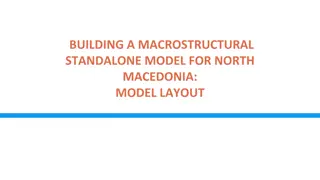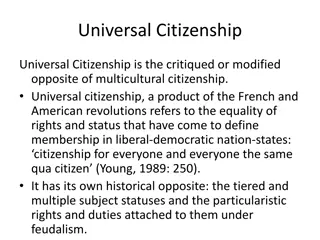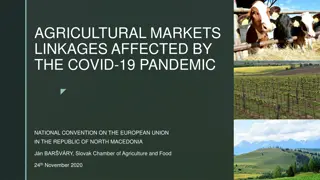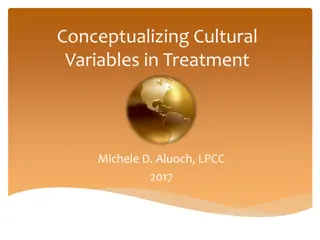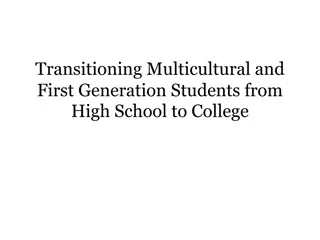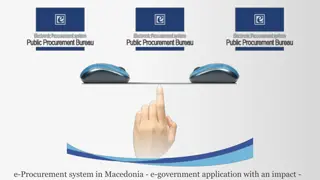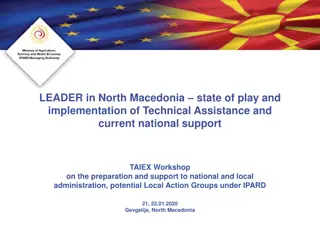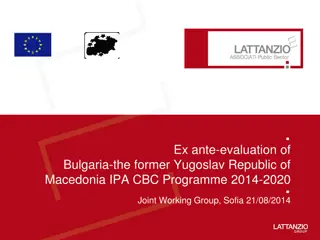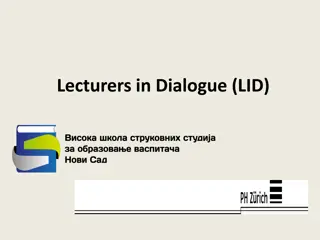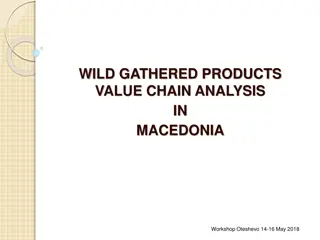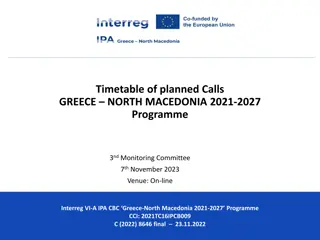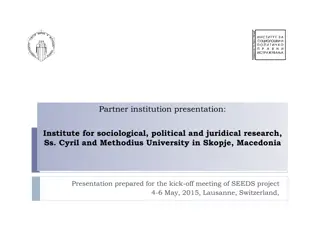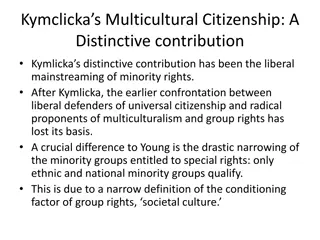Multicultural Teaming Workshop in Macedonia
This workshop in Macedonia focuses on building awareness of cultural diversity and enhancing communication within multicultural teams. Sessions cover key aspects such as cultural context, team awareness, and planning for progress. Participants are encouraged to commit to action steps to thrive in diverse team settings.
Download Presentation

Please find below an Image/Link to download the presentation.
The content on the website is provided AS IS for your information and personal use only. It may not be sold, licensed, or shared on other websites without obtaining consent from the author.If you encounter any issues during the download, it is possible that the publisher has removed the file from their server.
You are allowed to download the files provided on this website for personal or commercial use, subject to the condition that they are used lawfully. All files are the property of their respective owners.
The content on the website is provided AS IS for your information and personal use only. It may not be sold, licensed, or shared on other websites without obtaining consent from the author.
E N D
Presentation Transcript
Multicultural Teaming Workshop MACEDONIA, DECEMBER 9-10, 2016
Multicultural Team
Purpose Individual: each individual will commit to at least one action step to not just survive but thrive in their multicultural team context. To help SEND missionaries and their teammates in Macedonia grow in awareness of cultural diversity and plan to use that diversity to the greatest advantage in fulfilling the ministry to which God has called them. Team: each team will commit to a few next steps to overcome the unique challenges of multicultural teaming.
Overview Session 1 The Realities of Multicultural Teaming in SEND Session 2 Digging Deeper into Cultural Diversity Session 3 An Exercise in Building Team Awareness Session 4 Responding to Cultural Diversity Session 5 Planning for Progress as a Multicultural Team
The Communication Challenge Low Context: Good communciation is verbal - precise, simple, clear. Messages are expressed and understood by the words used. High Context: Good communication is less verbally explicit and depends on an understanding of cultural context. Messages are often implied but not plainly expressed. Low & High Context Communication
Multicultural teams must learn to communicate in low-context ways because the multicultural environment confuses the cues that are necessary for high-context communication. For the direct (low context) communicators: try to be more indirect and a softer communicator. Build relationships. For the indirect (high context) communicators: aim for a more direct style. Even though it might feel awkward and rude to you, remember that the direct communicator cannot pick up on the subtle clues that seem obvious to you. Avoid directly disagreeing with co-workers, and voice disagreements in more subtle ways. Be less confrontational and use words like maybe and perhaps more often. Become more aware of nonverbal cues
SESSION 1 Realities of Multi-cultural Teaming in SEND
Macedonia Team By citizenship Introduce Yourself (1 minute each) How would you define yourself culturally? Not just your citizenship, but other factors that have influenced who you are culturally (e.g. previous citizenship, parents nationality, significant exposure to other cultures, specific cultural context within your home country, etc.)
Citizenship of SEND Members (2016) US 361 Austria - 2 Canada 75 Poland - 2 Philippines 37 Taiwan 2 Hong Kong 17 Columbia 1 Germany 14 Costa Rica 1 Guatemala - 11 Iceland 1 Switzerland 5 Ireland 1 Australia 4 Russia 1 Honduras - 3 TOTAL 538 members
Sending Offices / Mission Partnerships Vereinigte Deutsche Missionshilfe e.V (VDM) - Germany SEND Canada Office Deutsche Missions Gemeinschaft (DMG) Germany SEND East Asia Sending Office Hong Kong Sweizerische Missions-Gemeinschaft (SMG) Switzerland Bund Evangelikaler Gemeinden sterreich (BEG) Austria SEND Philippine Sending Office UFM Worldwide UK FAM Internacional (FAM) Central America (10 countries) SEND US Office Australia Missionary Tidings (AMT) Interserve Australia SIM Australia SIM East Asia Singapore (5 countries represented) Missions Mobilization Ministry of Ukraine (3M)
SEND Value Unity in Diversity "We incorporate missionaries of many nationalities in the task of discipling the nations. Our desire is to have a multinational membership working together in harmony towards the fulfillment of the Great Commission."
SENDs majority culture (American) How others view them How they view themselves
SESSION 2 Digging Deeper Into Cultural Diversity
Different Ways of DOING Things Holiday Which holiday of the year do you think is most significant in your country and how do you celebrate it? (1 minute each in your group) Andy, Debby, Scott Jonathan, Pastor Pero, Noelle Ron, Patricia, Brian Michael, Dawn, Peter Herbert, Nadine, Lynn Larry, Sherri, Lisa Tourlant, Meredith, Cindy Philip, Emily, Leslie
How can we develop a deeper understanding of our cultural differences? Brainstorm ideas on this topic. (about 10 minutes) List down all ideas on a cling sheet. Don't evaluate any idea, just list. Everyone share at least 1 idea. Generational Groups: 20's 30's 40's 50's and above
Categorizing Cultural Differences Hot / Cold Cultures - Foreign to Familiar Sarah A Lanier Hot-climate cultures cultures that are relationship-based . They are generally found in warmer climates though there are exceptions. Examples include most Latin American countries, parts of Africa and Asia. Cold-climate cultures cultures that are task-oriented . They are generally found in colder climates, with exceptions. Examples include the northern United States, Western Europe and Israel.
Categorizing Cultural Differences Lingenfelter s 12 Paired Values Questionnaire Time / Event Dichotomistic Thinking / Holistic Thinking Crisis / Non-crisis Task / Person Status / Achievement Conceal Vulnerability / Show Vulnerability
Categorizing Cultural Differences Hofstede s Cultural Dimensions Website Country Comparison Power Distance Index Individualism vs Collectivism Masculinity vs. Femininity Uncertainty Avoidance Index Long Term Orientation versus Short Term Normative Orientation Indulgence vs. Restraint
Personal Reflection Are you committed to multicultural teaming? If so, please write down your commitment, dated and signed.
Categorizing Cultural Differences Erin Meyer s Culture Map Erin's Explanation Communicating - low-context or high-context communication? Evaluating Direct or indirect criticism? Persuading - principles first or applications first in proving a point? Leading egalitarian or hierarchical? Deciding consensual or top-down? (Not necessarily linked to where they are on the egalitarian/ hierarchical scale.) Trusting based on relationship or on working partnership? Disagreeing - helpful or harmful? Scheduling linear or flexible?
Categorizing Cultural Differences Assessment: What's Your Cultural Profile please complete this before tomorrow s sessions. Bring your results tomorrow. Tools: Different Products that you can potentially use on your teams
Find all these Resources on the SENDU Wiki Other helpful tools?
SESSION 3 An Exercise in Building Team Awareness
Building Awareness on Your Team Group by Team Share Results from What s Your Cultural Profile Go through each Scale one at a time: Plot each person s results on the continuum provided Read the Description provided Discuss briefly how your differences on each scale could be a challenge and a benefit to your team Spend less than 5 minutes on each of the 8 scales.
Erin Meyers 8 Scales 1. Communicating - low-context or high-context communication? 2. Evaluating Direct or indirect criticism? 3. Persuading - principles first or applications first in proving a point? 4. Leading egalitarian or hierarchical? 5. Deciding consensual or top-down? (Not necessarily linked to where they are on the egalitarian/ hierarchical scale.) 6. Trusting based on relationship or on working partnership? 7. Disagreeing - helpful or harmful? 8. Scheduling linear or flexible?
Identify the top challenges for your team Each person gets 4 dots Place a dot beside the3 challenges that you think are the most significant for SEND Macedonia. Put an additional dot on the one you think is the biggest challenge.
SESSION 4 Responding to Cultural Diversity
Natural Responses to Cultural Diversity Brainstorm:
Biblical Response to Cultural Diversity What Bible passages can be applied to working together on a multicultural team? List references and basic idea of each passage. Groups: Men / Women
Some principles for growing in effectiveness as a multinational team Choose to see each other as good-willed people. Believe your teammate has good intentions, even if you may experience miscommunication and conflict. Thank the Lord that He has brought your team together for a purpose. Remember that you share the same final goal We have a real enemy, and it's not your teammate A humble learning approach is a starting point
Don't gossip Exhort in love Pray together Remember everyone has a voice Listen more than talk Eat together in small groups Play together Ask questions Laugh together Cry together
Assume the best about people Be inquistive and suspend judgment Forgive Ask for forgiveness Keep short accounts Be open to other opinions / criticisms / differences Focus on similarities; capitalize on differences Think of unity rather than uniformity Celebrate the differences Love them.
Personal Reflection / Action Steps 1. Identify one idea that has impacted your thinking so far in this workshop. 2. Plan at least one action step that you are going to do in response. Write it down. Make it a SMART goal: Specific, Measurable, Achievable, Realistic and Time-bound. e.g. 1. The way I perceive a culture foreign to me may be very different from the way someone from yet another culture views that culture. 2. I will read Erin Meyer s Culture Map by the end of 2016. During break, I will ask Scott to help bring reconciliation between me and my teammate and set a time for the three of us to meet later today.
SESSION 5 Planning for Progress as a Multicultural Team
Since God chose you to be the holy people He loves, you must clothe yourselves with tenderhearted mercy, kindness, humility, gentleness, and patience.Make allowance for each other s faults, and forgive anyone who offends you. Remember, the Lord forgave you, so you must forgive others. Above all, clothe yourselves with love, which binds us all together in perfect harmony. And let the peace that comes from Christ rule in your hearts. For as members of one body you are called to live in peace. And always be thankful (Col 3:12-15 NLT)
Recap Session 1 The Realities of Multicultural Teaming in SEND Session 2 Digging Deeper into Cultural Diversity Session 3 An Exercise in Building Team Awareness Session 4 Responding to Cultural Diversity Session 5 Planning for Progress as a Multicultural Team
Plan Key Next Steps (per team) 1.Discuss the top multicultural teaming challenge for your team. (5 minutes) 2.Choose an activity (from the lists) that your team will do to deal with this challenge. (5 min.) 3.Plan the activity. (10 minutes) Specific, Measurable, Achievable, Realistic, Time-bound What, Who will give leadership, When 4.Repeat Steps 2-3 for a second activity OR Steps 1-3 for another key challenge for your team. (10 - 20 minutes) Leave time to plan how/when your team will discuss other issues that may have surfaced in this workshop so they don t get lost. (SMART) (10 20 minutes)



